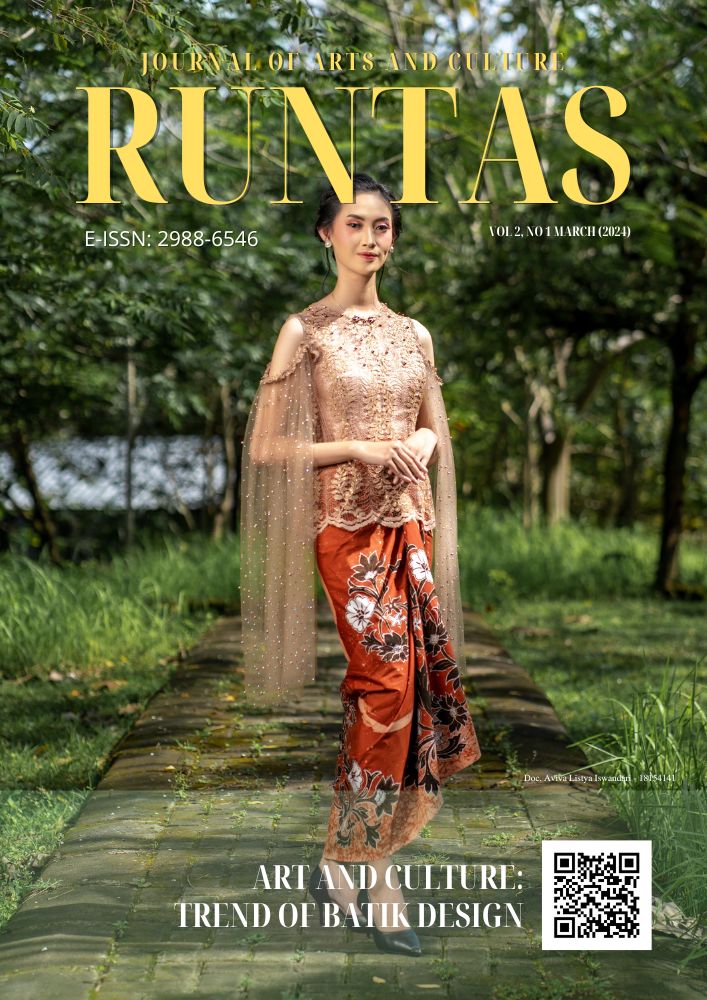THE MOJOARUM SITE AS A SOURCE OF IDEAS FOR CREATING BATIK MOTIFS FOR KEBAYA CLOTHES
DOI:
https://doi.org/10.33153/runtas.v2i1.4846Keywords:
Batik Tulis, Kebaya, Mojoarum SiteAbstract
This study aims to make Mojoarum Site as a source of inspiration in creating batik motif for Javanese blouse. The artwork creation process begins with exploration stage by doing direct observation toward Mojoarum site. The results of the observations are then used as a batik motif on Javanese blouse. Designing process is the next stage after exploration where, at this stage, the selection of the most suitable batik motifs is carried out. The last step is embodiment process in which this step uses covering and dying technique in creating batik motifs. Naphthol was chosen as coloring matter for resulting sense of beauty to the artwork. Overall, the embodiment process comprises nyorek (creating pattern), membatik (drawing batik motif), coloring, melorod (releasing wax from fabric), sewing, and finishing. This creation process resulted in four works and each one was named according to the history of the formation of the Mojoarum site as a village. The name of the first work is Slobog Paceklik, the second work is Udan Liris Bramantha, the third work is Sidomukti Sutrepta, and the fourth work is Sidomukti Rahayu Windraya. We then call the batik motifs relulted from this artwork creation as Mojoarum Batik Motif. It is expected that the society inspired to be more care with environment and tries to maintain cultural preservation through the creation of Mojoarum Batik Motifs.
Downloads
References
Al-Anshori, H. (2019). Perjalanan Panjang Desa Wisata Jarum. Insanwisata.Com. https://insanwisata.com/desa-wisata-jarum/
Audriana, I. (2016). Kebaya Kutubaru Sebagai Ide Penciptaan Karya Seni Tekstil. Universitas Brawijaya.
Fikri, M. A. (2015). Batuan Mineral sebagai Alternatif Bahan Pewarna Alami. 19, 16112107.
Fitria, F., & Wahyuningsih, N. (2019). Kebaya kontemporer sebagai pengikat antara tradisi dan gaya hidup masa kini. Jurnal Seni Rupa, 7. https://jurnal.isbi.ac.id/index.php/atrat/article/view/617
Gustami, S. P. (2007). Butir-butir mutiara estetika timur: ide dasar penciptaan seni kriya Indonesia. Prasista.
Hidayah, N. (2019). Sejarah dan Legenda Desa di Temanggung, Magelang, dan Semarang.
Indonesia, D. (2015). Sejarah Kebaya Kutubaru, Kebaya Klasik Indonesia. Dewi Magazine, 1
Musman, A., & Arini, A. B. (2011). Batik : Warisan Adiluhung Nusantara
Pentasari, R. (2007). Chic in Kebaya. Esensi.
Wahyudiarto, D. (2006). Bathik Sebagai Busana Dalam Tatanan Dan Tuntunan. In Gelar (Vol. 2, Issue 4, pp. 370–374).
Pelatihan Batik Tulis Dengan Media Pewarna Naptol Garam Bagi Siswa Panti Asuhan Yayasan Muslim surabayatantra Sakre, Sepbianti Rangga Patriani(2021) 1(1)
Sudarwanto, A., Seni, j. K., rupa, s., & desain, d. (2010). Penerapan model bentuk tranformasi menggunakan teknik karakter terkuat untuk menghasilkan motif batik.
Guntur, p. (2016). Makalah p.guntur. Penelitian artistik: sebuah paradigma alternatif, 1–21.
Guntur. (2011). Teba Kriya. In Teba Kriya (Vol. 2, Issue 1). Cetakan ISI Press Solo.
Purnomo, M. A. J., & Cahyana, A. (2019). BATUAN PEWARNA PURBA SEBAGAI ALTERNATIF BAHAN PEWARNA ALAMI BATIK RAMAH LINGKUNGAN SEBAGAI PENCIRI PENGUATAN KARAKTER DAERAH SRAGEN. ARTISTIK, 3(1), 1–31. http://repository.isi-ska.ac.id/4047/1/Drs. H M. Arif Jati Purnomo%2C M.Sn..pdf
Ramadhan, A. (2021). Perbedaan Stilasi, Deformasi Dan Distorsi Lengkap Dengan Contoh Karyanya. https://seputarkelas.com/perbedaan-stilasi-deformasi-dan-distorsi-lengkap-dengan-contoh-karyanya/









